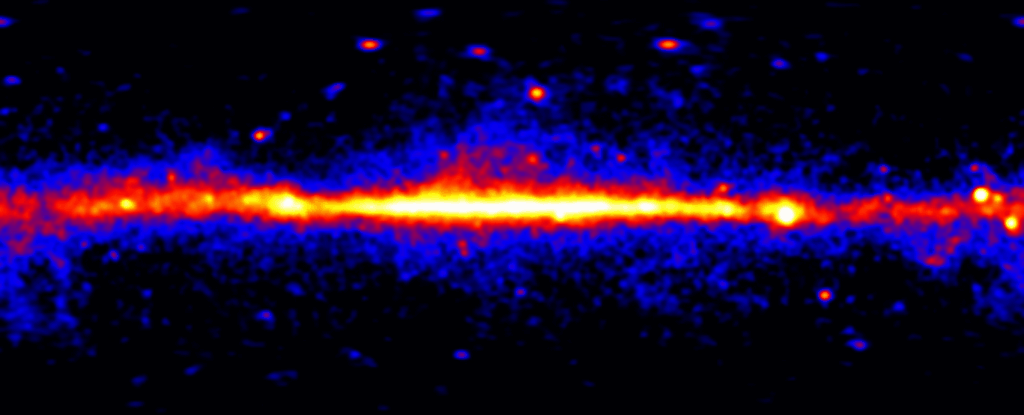Most of the light streaming through our Universe is invisible to human eyes.
The spectrum ranges from long radio waves to short gamma rays, with the visible part occupying just a tiny slice in the middle. But, thanks to telescope technology, we’re able to peer into other slices of the spectrum, and see all the light in the sky.
NASA’s Fermi Gamma-Ray Space Telescope is one such instrument. Gamma radiation is the most energetic light in the cosmos, and it’s produced by energetic sources such as supernova remnants, pulsar stars, and quasar and blazar galaxies, powered by supermassive black holes whose monstrous appetites produce light that roars across space and time.
Gamma radiation is difficult to see from here on Earth’s surface, since it’s blocked by our atmosphere. That’s a good thing, because it can be pretty dangerous, but it does mean that we need to get creative about studying it. And one solution is: if the atmosphere prevents us from observing gamma rays, go somewhere where the atmosphere isn’t
Fermi was launched in 2008, and since then it has been taking full advantage of its position to study the sources of gamma radiation in our Universe. We’ve seen an animation of the gamma-ray sources it has seen over the course of a year, from February 2022 to February 2023.
And now, NASA scientists have compiled a timelapse of its actual data, collected between August 2008 and August 2022.
frameborder=”0″ allow=”accelerometer; autoplay; clipboard-write; encrypted-media; gyroscope; picture-in-picture; web-share” allowfullscreen>
“One of the first things to strike your eye in the movie is a source that steadily arcs across the screen,” says astronomer Judy Racusin of NASA’s Goddard Space Flight Center, who narrates the timelapse. “That’s our Sun, whose apparent movement reflects Earth’s yearly orbital motion around it.”
The Sun is a steady source of relatively dim gamma radiation. Scientists believe it doesn’t emit gamma radiation from within, but as a result of constant bombardment from cosmic radiation particles that are always streaming through the Universe. When they hit the Sun, the interaction with the solar atmosphere produces gamma radiation.
Every now and then, though, the Sun erupts in a massive flare that produces X- and gamma rays, becoming, for a brief time, the brightest thing in the gamma-ray sky. (Given that the Sun is a star and very close to us, it is often the brightest thing in the sky, but gamma radiation is the exception, as you can see in the timelapse.)
Most of the gamma-ray sources Fermi sees are blazar galaxies. These are distant galaxies with an active supermassive black hole. The black hole doesn’t give off light, but it is feeding from an immense cloud of dust and gas that roils violently around it.
This cloud is very hot and very bright, on its own, but the gamma radiation Fermi sees comes from jets of material that are diverted along magnetic field lines outside the black hole, and ejected from its poles at extreme speeds. A blazar galaxy is one that has one of these jets pointed directly at us, so it appears much brighter than one pointing in another direction.
These jets can flicker in brightness, which is one of the things Fermi scientists look out for.
“The bright, steady gamma-ray glow of the Milky Way is punctuated by intense, days-long flares of near-light-speed jets powered by supermassive black holes in the cores of distant galaxies,” describes Seth Digel of SLAC National Accelerator Laboratory, who created the images.
“These dramatic eruptions, which can appear anywhere in the sky, occurred millions to billions of years ago, and their light is just reaching Fermi as we watch.”
Other sources of gamma radiation include supernova remnants such as the Crab Nebula, exploding stars, and pulsars. Shorter duration events, such as gamma-ray bursts from supernovae, don’t appear in the timelapse because of the way the data was processed.
But rest assured, they are not going unnoticed. Every blip Fermi detects is of interest to the scientists poring over the wealth of data coming in.
Fermi was only planned to run for 5 to 10 years. So far, it’s been running for over 15.5, and counting. If we’re lucky, we may be in for a whole lot more, revealing to us the secrets of the most powerful events and objects in the Universe.





